Wind Turbine Rotor Blade Market Size
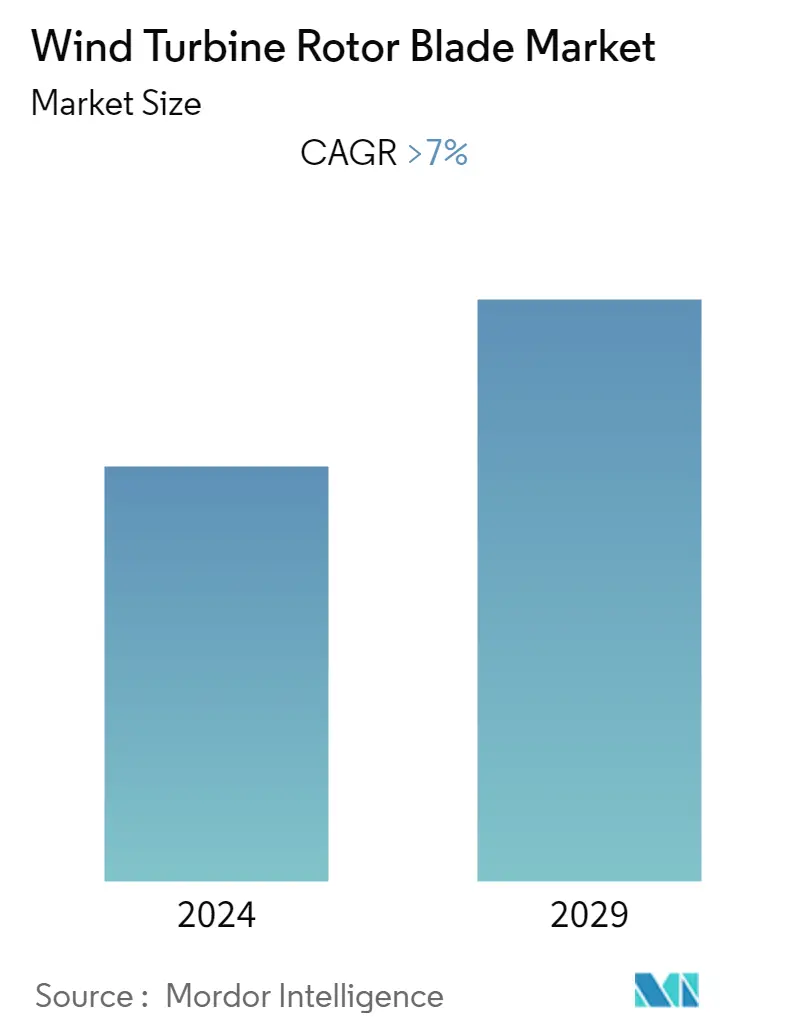
| Study Period | 2020 - 2029 |
| Base Year For Estimation | 2023 |
| CAGR | 7.00 % |
| Fastest Growing Market | Asia-Pacific |
| Largest Market | Asia Pacific |
| Market Concentration | Low |
Major Players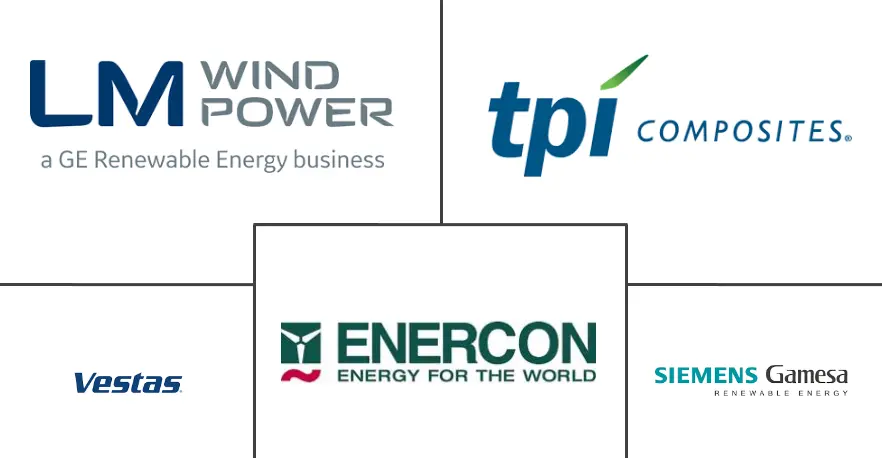
*Disclaimer: Major Players sorted in no particular order |
Wind Turbine Rotor Blade Market Analysis
The Global Wind Turbine Rotor Blade Market size was estimated at about USD 20.49 billion in the current year and is projected to register at a CAGR of more than 7% during the forecast period.
The market was moderately impacted by COVID-19 in 2020. Presently, the market has reached pre-pandemic levels.
- The major driving factor of the market is the growing number of offshore and onshore wind energy installations across the world.
- On the flip side, the associated high cost of transportation and cost competitiveness of alternate clean power sources, like solar power, hydropower, etc., have the potential to hinder market growth.
- The wind power industry has been in demand for cost-effective solutions, and a highly efficient product has the potential to change the dynamics of the industry. There were instances where old turbines were replaced, not because of the damage but due to the availability of more efficient blades in the market. Hence, technological developments present themselves as opportunities for the wind turbine rotor blade market.
- Asia-Pacific dominated the wind turbine rotor blade market in 2022, with the majority of the demand coming from countries like China, India, and Australia.
Wind Turbine Rotor Blade Market Trends
This section covers the major market trends shaping the Wind Turbine Rotor Blade Market according to our research experts:
Onshore Segment to Dominate the Market
- The onshore wind energy power generation technology has evolved over the last five years to maximize electricity produced per megawatt capacity installed and to cover more sites with lower wind speeds. Besides this, in recent years, wind turbines have become larger with taller hub heights, broader diameters, and larger wind turbine blades.
- According to the Global Wind Energy Council (GWEC), the onshore wind market added 72.5 GW worldwide in 2021, 18% lower than in 2020, due to a slowdown in the growth of the onshore wind market in China and the United States, the world's two largest wind markets. However, in 2021, explosive growth was witnessed in Europe, Latin America, Africa, and the Middle East, where new onshore installations increased by 19%, 27%, and 120%.
- Onshore wind additions in the Asia-Pacific and North America have decreased by 31% and 21% compared to 2020, but the two regions combined still made up more than two-thirds of global onshore wind installations in 2021. However, investments and ambitious renewable targets from several major countries, such as China, the United States, and India, are expected to drive the demand for wind turbine rotor blade during the forecast period.
- Further, according to the International Renewable Energy Agency (IRENA), the levelized cost of energy (LCOE) and global weighted average total installed cost decreased from 0.060 USD/kWh and 1652 USD/kW in 2016 to 0.039 USD/kWh and 1355 USD/kW in 2020. In addition, the LCOE and the weighted average cost are expected to decline further owing to the reductions in capital costs, increased competition as the sector continues to mature, and improvements in technology during the forecast period.
- India is one of the fastest-growing wind power generators. According to India's Ministry of New and Renewable Energy, as of 2021 the country had the fourth-highest installed wind energy capacity in the world, with a total installed capacity of 40.08 GW. The expansion of the wind industry has resulted in a robust ecosystem, project operation capabilities, and a manufacturing base of about 10,000 MW per annum in the country. China follows the same trend. According to the National Energy Administration (NEA), 47.5 GW of wind capacity was grid-connected in 2021, and the total onshore installed wind capacity registered at 310.62 GW. Due to high investment and changes in government policy, the onshore segment is expected to lead the growth of the wind turbine rotor blade market in India and China.
- According to the GWEC, the United States' onshore wind sector reported the second-highest annual new installations in the world in 2021, with around 12.74 GW commissioned. The onshore wind installation in the United States was driven primarily due to the planned Production Tax Credit phase-out as project developers had to meet their deadline, which also directly aids the onshore wind turbine rotor blade market.
- Further, according to WindEurope, onshore wind energy will lead the market demand in the European region to achieve net-zero carbon emissions by 2030. According to GWEC, onshore wind energy capacity takes around 90% of wind energy. Strict regulations to reduce carbon emissions and phase out conventional power systems are expected to drive the market.
- Therefore, based on the above-mentioned factors, the onshore wind turbine rotor blade segment is expected to grow due to declining LCOE and reduced CAPEX, coupled with high energy demand through clean sources, during the forecast period.
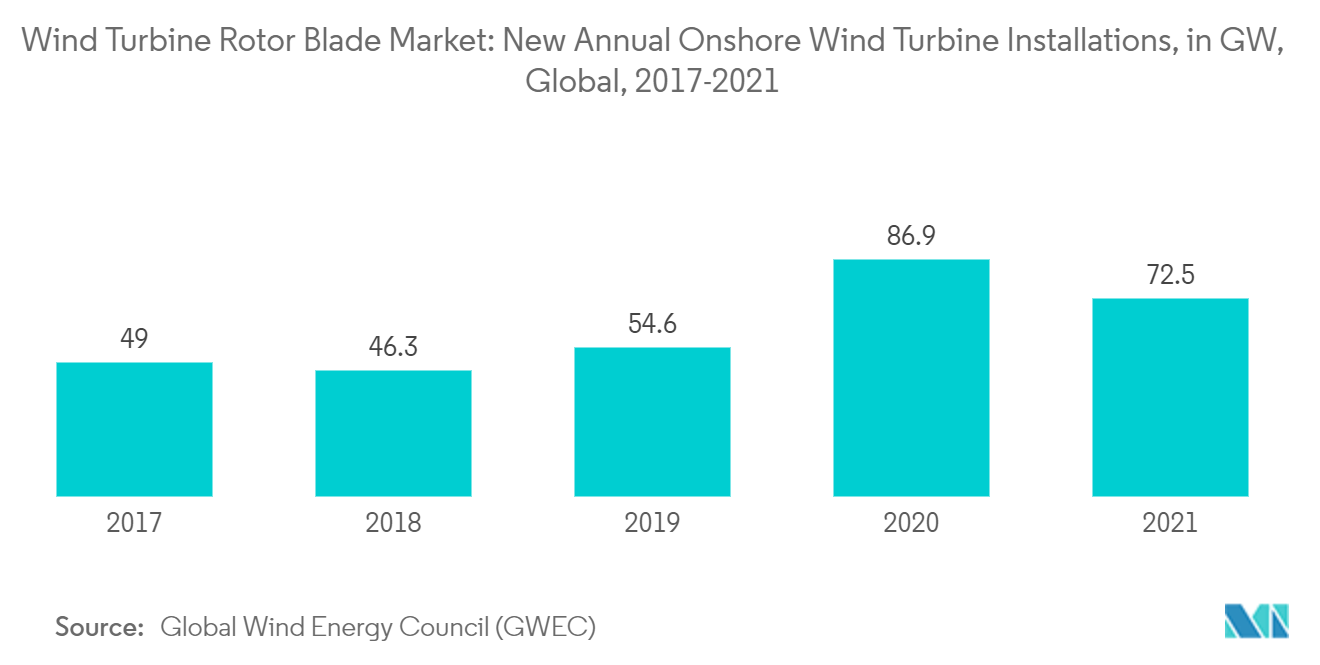
Asia-Pacific to Dominate the Market
- Asia-Pacific is one of the largest regions in the global wind turbine rotor blade market. Most of the demand is generated from China, India, and Japan. Since the invention of the modern wind turbine generator (WTG) in 1891, China has recognized that wind energy technology offers an effective way to provide electricity to rural and isolated areas. China's installed wind capacity grew from a mere 4 MW in 1990 to 338.30 GW in 2021 due to policy reforms, dedicated R&D initiatives, new financing mechanisms, and clear goals in the most recent Five-Year Plans.
- Both China's installed capacity and new capacity in 2021 were the largest in the world by a wide margin. According to IRENA, China is expected to continue to dominate the onshore wind power industry, with more than 50% of global installations by 2050. Also, due to the high population, high electricity demand in the country is expected to promote growth in wind energy. Several multinational corporations, including Chinese firms, are investing in this sector with the help of federal and provincial governments across the country.
- According to the National Energy Administration (NEA), China connected 47.5 GW of onshore wind capacity in 2021, boosting its total onshore installations to 310.62 GW. Further, the Chinese onshore wind market is expected to grow steadily in the coming years, with rising needs for key components and materials, not only for the national market but also for international exports. Besides, in China, nearly 70% of the electricity produced is from thermal energy sources. As there is increasing pollution from thermal sources, the country has been focusing on increasing the share of cleaner and renewable sources in power generation.
- Furthermore, out of the total 21.10 GW of newly installed offshore capacity worldwide, 80% (16.90 GW) of the new installations came from China in 2021, and China's cumulative offshore wind capacity stood at 27.68 GW. All of this indicates that China is expected to be the largest market for wind turbine rotor blades market in the Asia-Pacific region.
- India held the fourth-largest wind power installed capacity globally as of 2021. These projects are majorly spread in the northern, southern, and western parts of the country. As of 2021, India's total installed wind capacity was 40.08 GW, witnessing an increase of 4% compared to the 38.62 GW in 2020. The country's current share of non-fossil fuels in overall generation capacity stands at 38.5% out of 395 GW. While wind currently accounts for 10.2% of this, to further realize its 2030 climate commitments, the Ministry of New and Renewable Energy (MNRE) has estimated that 140 GW of wind energy capacity is required by 2030. In order to reach such a target, the number of wind projects is expected to increase drastically in the coming years, driving the demand for wind power equipment in the country.
- Furthermore, India is trying to expand its green energy portfolio by harnessing the entirely unexploited offshore wind energy potential along its 7,600-kilometer coastline. The focus on offshore increased in recent years. The renewable energy ministry has set a target of 30 GW of offshore wind installations by 2030.
- Therefore, factors, such as upcoming wind power projects, along with supportive government policies and regulations in different countries across the region, are expected to increase the demand for wind turbine rotor blades in the Asia-Pacific during the forecast period.
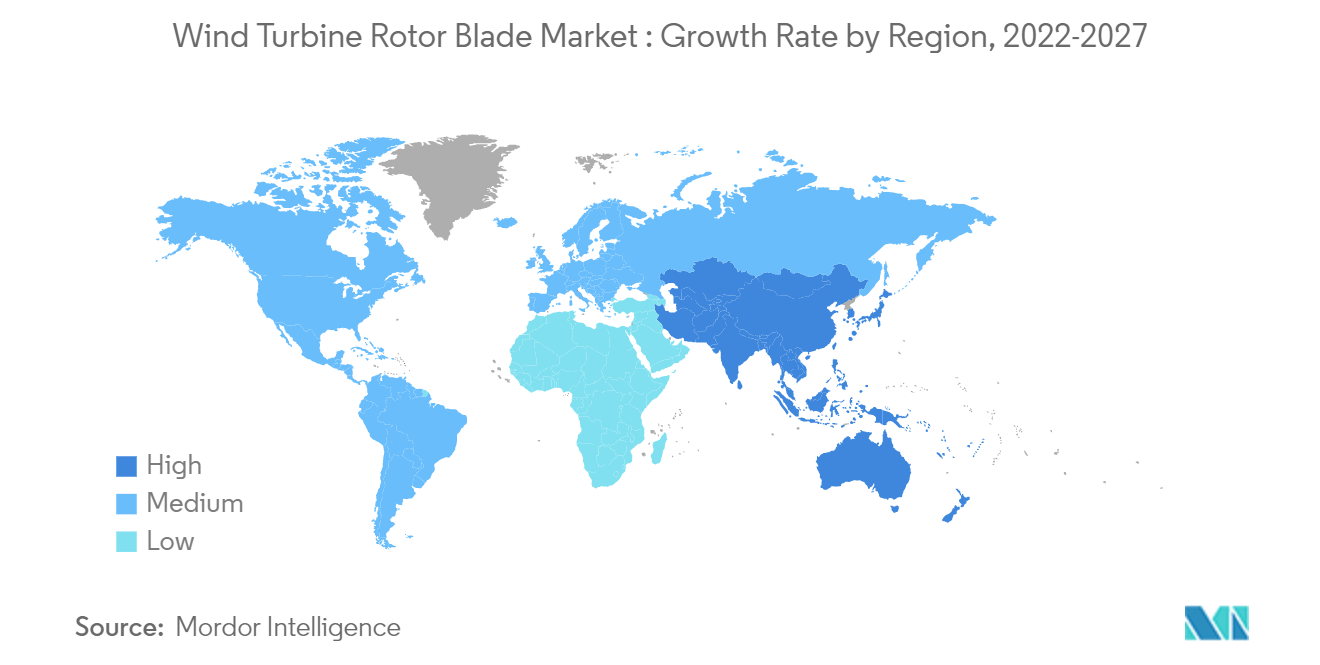
Wind Turbine Rotor Blade Industry Overview
The wind turbine rotor blade market is fragmented in nature. Some of the major players in the market (in no particular order) include TPI Composites SA, LM Wind Power (a GE Renewable Energy business), Siemens Gamesa Renewable Energy, S.A., Vestas Wind Systems A/S, and Enercon GmbH.
Wind Turbine Rotor Blade Market Leaders
-
TPI Composites SA
-
Vestas Wind Systems A/S
-
Enercon GmbH
-
LM Wind Power (a GE Renewable Energy business)
-
Siemens Gamesa Renewable Energy, S.A.
*Disclaimer: Major Players sorted in no particular order
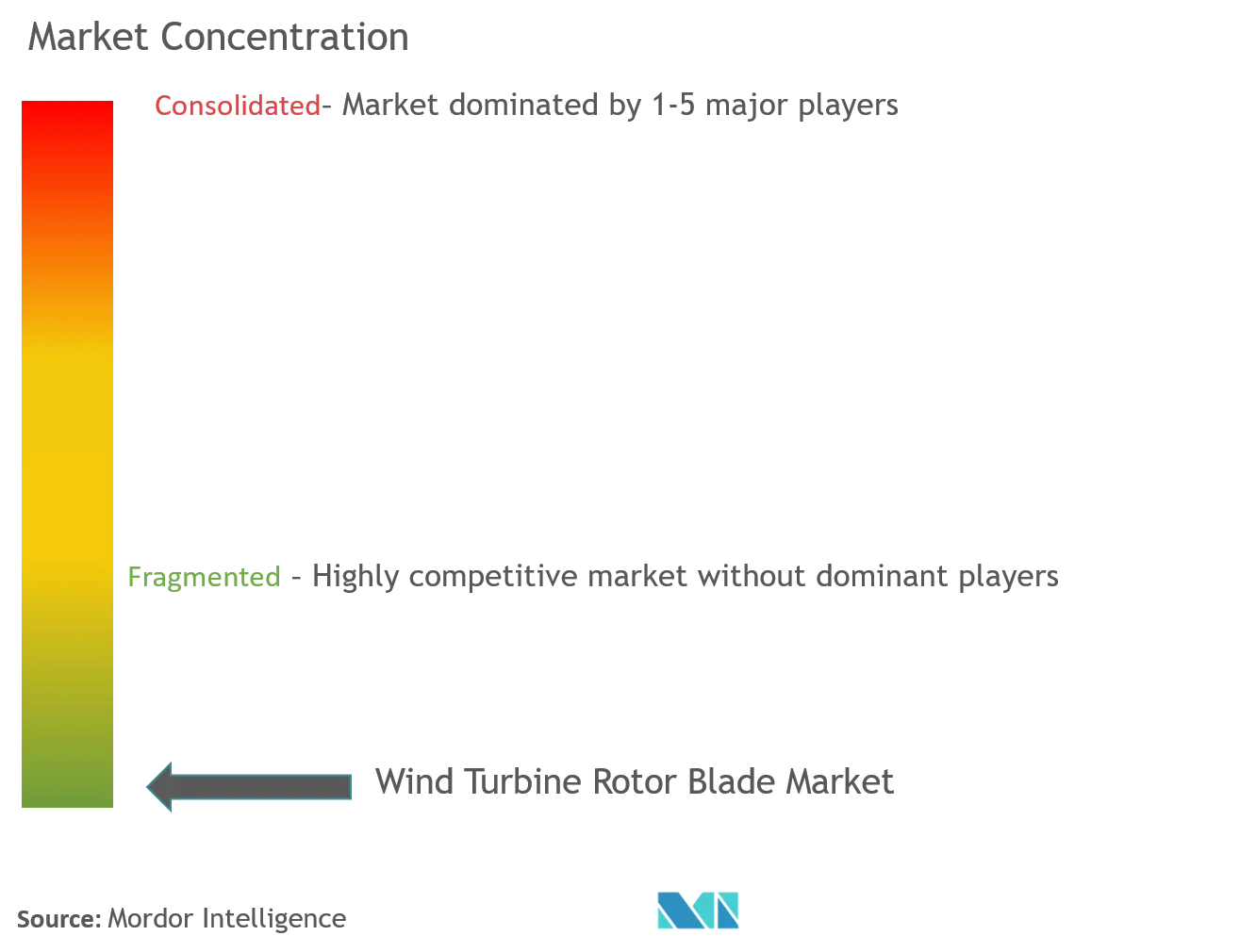
Wind Turbine Rotor Blade Market News
- March 2022: The ZEBRA (Zero Waste Blade Research) consortium is a new step in the wind energy industry's transition to a circular economy with the production of its 100% recyclable wind turbine prototype blade. The 62-meter blade was made using Arkema's Elium resin, a thermoplastic resin well known for its recyclable properties, and the new high-performance Glass Fabrics from Owens Corning.
- March 2022: Hitachi Power Solutions will commence advanced services titled - Blade Total Service. It is expected to mitigate the risks of wind power facilities, including deterioration due to wear and tear of rotating blades, the stress imposed by violent winds during typhoons, and damage caused by lightning - by combining AI and other digital technologies with cutting-edge drone technology.
Wind Turbine Rotor Blade Market Report - Table of Contents
1. INTRODUCTION
- 1.1 Scope of the Study
- 1.2 Study Assumptions
2. EXECUTIVE SUMMARY
3. RESEARCH METHODOLOGY
4. MARKET OVERVIEW
- 4.1 Introduction
- 4.2 Market Size and Demand Forecast in USD billion, till 2027
- 4.3 Wind Turbine Rotor Blades Price Analysis
- 4.4 Recent Trends and Developments
- 4.5 Government Policies, Regulations, and Targets
-
4.6 Market Dynamics
- 4.6.1 Drivers
- 4.6.2 Restraints
- 4.7 Supply Chain Analysis
-
4.8 Porter's Five Forces Analysis
- 4.8.1 Bargaining Power of Suppliers
- 4.8.2 Bargaining Power of Consumers
- 4.8.3 Threat of New Entrants
- 4.8.4 Threat of Substitutes Products and Services
- 4.8.5 Intensity of Competitive Rivalry
5. MARKET SEGMENTATION
-
5.1 Location of Deployment
- 5.1.1 Onshore
- 5.1.2 Offshore
-
5.2 Blade Material
- 5.2.1 Carbon Fiber
- 5.2.2 Glass Fiber
- 5.2.3 Other Blade Materials
-
5.3 Geography
- 5.3.1 North America
- 5.3.2 Europe
- 5.3.3 Asia-Pacific
- 5.3.4 South America
- 5.3.5 Middle East and Africa
6. COMPETITIVE LANDSCAPE
- 6.1 Mergers and Acquisitions, Joint Ventures, Collaborations, and Agreements
- 6.2 Strategies Adopted by Leading Players
-
6.3 Company Profiles
- 6.3.1 TPI Composites Inc.
- 6.3.2 Lianyungang Zhongfu Lianzhong Composites Group Co. Ltd
- 6.3.3 LM Wind Power (a GE Renewable Energy business)
- 6.3.4 Nordex SE
- 6.3.5 Siemens Gamesa Renewable Energy, S.A.
- 6.3.6 Vestas Wind Systems A/S
- 6.3.7 MFG Wind
- 6.3.8 Sinoma wind power blade Co. Ltd
- 6.3.9 Aeris Energy
- 6.3.10 Suzlon Energy Limited
- 6.3.11 Enercon GmbH
- *List Not Exhaustive
7. MARKET OPPORTUNITIES AND FUTURE TRENDS
** Subject To AvailablityWind Turbine Rotor Blade Industry Segmentation
Wind turbine rotor blades are the key components of wind turbines, as they are in direct contact with high-speed winds. Rotor blades convert wind's kinetic energy into rotational energy, which is later converted into electrical energy. The global wind turbine rotor blade market is segmented by location of deployment, blade material, and geography. By location of deployment, the market is segmented into onshore and offshore. By blade material, the market is segmented by carbon fiber, glass fiber, and other blade materials. The report also covers the market size and forecasts for the wind turbine rotor blade market across major regions, namely North America, Europe, Asia-Pacific, South America, and Middle East and Africa. For each segment, the market sizing and forecasts have been done based on revenue (USD Billion).
| Location of Deployment | Onshore |
| Offshore | |
| Blade Material | Carbon Fiber |
| Glass Fiber | |
| Other Blade Materials | |
| Geography | North America |
| Europe | |
| Asia-Pacific | |
| South America | |
| Middle East and Africa |
Wind Turbine Rotor Blade Market Research FAQs
What is the current Wind Turbine Rotor Blade Market size?
The Wind Turbine Rotor Blade Market is projected to register a CAGR of greater than 7% during the forecast period (2024-2029)
Who are the key players in Wind Turbine Rotor Blade Market?
TPI Composites SA, Vestas Wind Systems A/S, Enercon GmbH, LM Wind Power (a GE Renewable Energy business) and Siemens Gamesa Renewable Energy, S.A. are the major companies operating in the Wind Turbine Rotor Blade Market.
Which is the fastest growing region in Wind Turbine Rotor Blade Market?
Asia-Pacific is estimated to grow at the highest CAGR over the forecast period (2024-2029).
Which region has the biggest share in Wind Turbine Rotor Blade Market?
In 2024, the Asia Pacific accounts for the largest market share in Wind Turbine Rotor Blade Market.
What years does this Wind Turbine Rotor Blade Market cover?
The report covers the Wind Turbine Rotor Blade Market historical market size for years: 2020, 2021, 2022 and 2023. The report also forecasts the Wind Turbine Rotor Blade Market size for years: 2024, 2025, 2026, 2027, 2028 and 2029.
Wind Turbine Rotor Blade Industry Report
The Global Wind Turbine Rotor Blade Market is a dynamic and evolving sector, segmented by location of deployment, blade material, and geography. The market forecast indicates a robust growth rate, driven by increasing demand for renewable energy sources and advancements in blade materials such as carbon fiber and glass fiber. The market analysis highlights significant trends and market growth across various regions including North America, Europe, Asia-Pacific, South America, and the Middle East and Africa.
Industry analysis reveals that both onshore and offshore deployments are contributing to the market value, with market leaders continuously innovating to enhance efficiency and durability. The market report provides a comprehensive market overview, detailing the market segmentation and market trends influencing the industry. The industry outlook is positive, with market research indicating a steady increase in market size and industry statistics supporting this growth.
The market review includes detailed industry reports and industry research, offering valuable insights into market predictions and market data. The market forecast suggests continued expansion, supported by favorable market conditions and increased investments in renewable energy infrastructure. The industry information encompasses market segmentation and industry sales, providing a holistic view of the market dynamics.
For those seeking in-depth knowledge, the report example and report pdf offer extensive market research and industry reports, making it an essential resource for understanding the market outlook and market overview. The market value and industry size are expected to rise, driven by technological advancements and supportive government policies.
Overall, the market trends and industry trends indicate a promising future for the Wind Turbine Rotor Blade Market, with market leaders playing a crucial role in shaping the market landscape. The industry outlook remains optimistic, with market data and industry statistics underscoring the potential for sustained market growth.



